In-situ LA-ICP-MS trace element and oxygen isotope signatures of magnetite from the Yamansu deposit, NW China, and their significance
2020-11-10ZhiyuanSunYuwangWangLingliLong
Zhiyuan Sun · Yuwang Wang · Lingli Long
Abstract The Yamansu iron deposit is hosted in submarine volcanic rocks in the Aqishan-Yamansu belt of Eastern Tianshan, NW China. A geological cross-section for the Carboniferous strata in the ore district shows that ore bodies in the Yamansu deposit are hosted in andesitic crystal tuff of the third cycle of the Carboniferous Yamansu Formation.This indicates an association between mineralization and volcanism. The orebodies are strata bound and lensoid and generally share the occurrence state of the host rocks. Magnetite mineralization mainly occurs asbreccia ores, ores in the mineralized volcanic rocks,massive ores, and sulfide-rich ores according to their structures and sequences of formation. Trace element compositions of magnetite from various types of ores were determined by LA-ICP-MS. The dataset indicates thatdifferent types of magnetite havedistinct trace element contents correlated to their formation environments.Magnetite crystals from breccia ores have high Ti, Ni, V, Cr, and Co and low Si, Al, Ca, and Mg contents, indicating crystallization from a volcanic magmatic eruption, which is consistent with field evidence of coexisting altered volcanic breccia. Magnetite crystals from ores in the mineralized volcanic rocks have moderate Ti, Ni, V, Cr, and Co contents. In contrast, magnetite from massive ores and sulfide-rich ores have low concentrations of Ti,Cr,Ni,and V,high concentrations of Si,Al,Ca,and Mg,and evidence of hydrothermal magnetite. In-situ magnetite compositions imply a magmatic-hydrothermal process. Although δ18O values for magnetite grains fromYamansu vary (+ 1.3 to + 7.0‰),they all plot in the range field of volcanic iron deposits, and they also record a magmatic-hydrothermal process. The compositions of Yamansu magnetites are interpreted as controlled mainly by temperature,fluid,host rock buffering, oxygen fugacity, and sulfur fugacity. The metallogenic conditions of the Yamansu deposit changed from high temperature and low oxygen fugacity to low temperature and high oxygen fugacity. However, more fluid-rock reactions and higher sulfur fugacity were involved during the deposition of massive ores and sulfiderich ores.
Keywords Magnetite · Trace element composition · LAICP-MS ·Oxygen isotope·Yamansu iron deposit·Eastern Tianshan
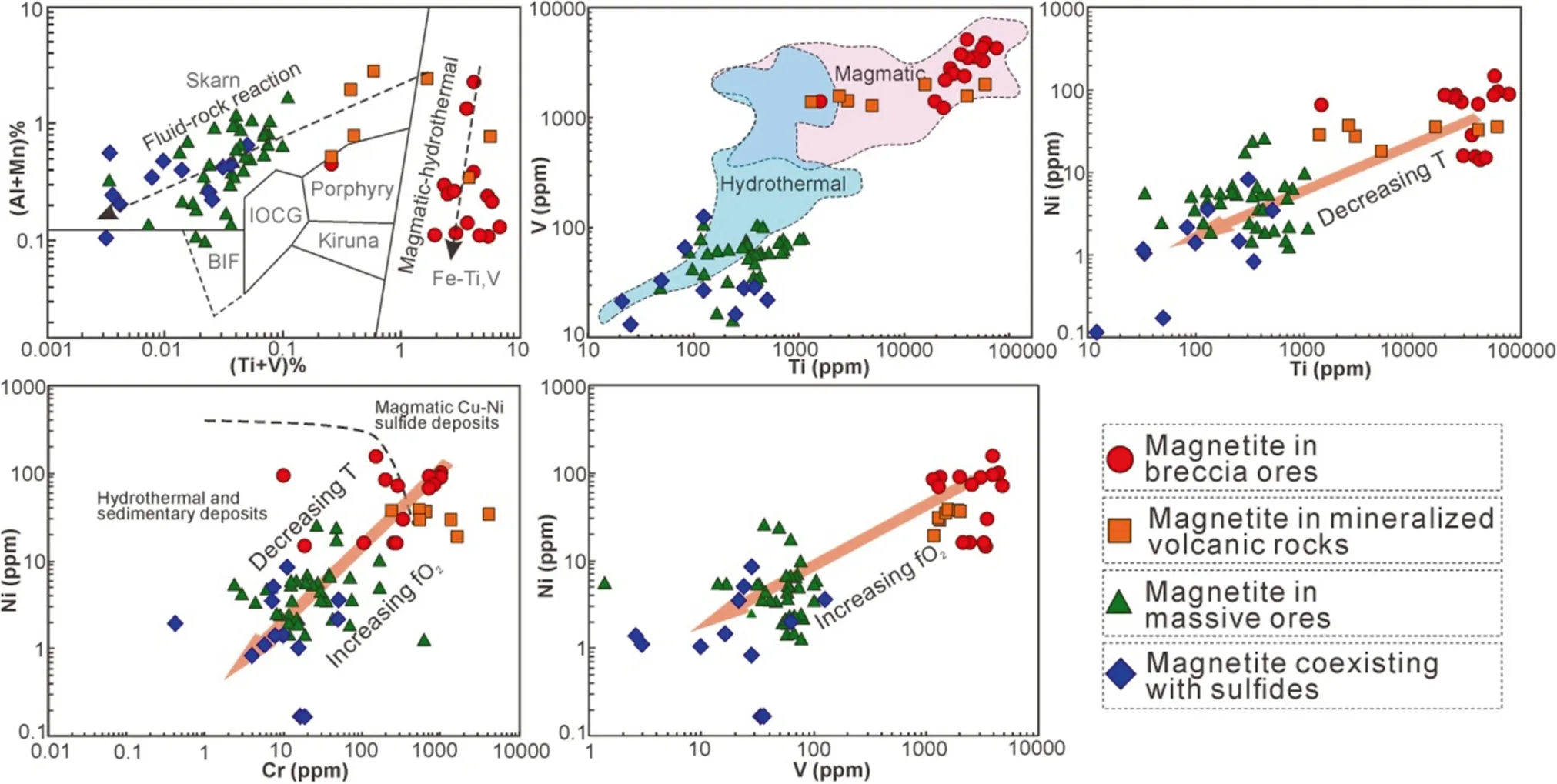
Graphic abstract
1 Introduction
The Aqishan-Yamansu belt is a significant metallogenic zone in the Eastern Tianshan Orogenic Belt(ETOB),which hosts valuable volcanic-hosted Fe-(Cu) deposits (Dong et al. 2011; Hou et al. 2014; Li et al. 2015). The Yamansu deposit is located in the east-central part of the Aqishan-Yamansu belt and is one of the largest Fe deposits in the ETOB(Huang et al.2018).This depositis similar to others of submarine volcanogenic origin, such as the Beizhan, Chagangnuoer, and Zhibo Fe deposits in the Awulaleiron metallogenic belt of the western Tianshan orogen (Zhang et al. 2016; Günther et al. 2017; Huang et al. 2018). However, the relationship between the evolution of volcanic eruption cycles and ore mineralization remains unclear in the types of deposits hosted in volcanic rocks, which hinders the understanding of the metallogenesis of this type of deposits. Given this situation, a geological cross-section of the Yamansu ore district is investigated in this study.
The contents of trace elements in magnetite vary greatly between magmatic and hydrothermal iron deposits.Therefore,concentrations of magnetite from a great variety of deposit types have been studied (Monteiro et al. 2008;Dupuis and Beaudoin 2011;Nadoll et al.2012,2014;Dare et al. 2012, 2014; Broughm et al. 2017). Furthermore, the trace element compositions of magnetitethat crystallized under different conditions in the same deposit vary greatly,and the likelihood of trace element incorporation mainly depends onthe fluid (magmatic and hydrothermal), crystallography(ionic radii and cations),temperature,host rock buffering, and oxygen and sulfur fugacities (Nielsen et al.1994; Toplis and Corgne 2002; Nadoll et al. 2014; Chen et al. 2015; Chung et al. 2015). In recent years, the improvement of in-situ laser ablation inductively coupled plasma mass spectrometry (LA-ICP-MS) analytical technology makes tracing the physiochemical conditions of the mineralization process with trace elements in magnetite possible(Nadoll et al.2014;Dare et al.2014;Huang et al.2019).In this study,we determined a combination of trace element compositions in magnetite by LA-ICP-MS and magnetite oxygen isotopes from various types of ores in Yamansu deposit to constrain the origin and evolution of the ore-forming fluids and to discuss possible factors controlling the chemical compositions of magnetite during iron formation.
2 Regional geological background

Fig.1 a Schematic tectonic map of the Central Asia Orogenic Belt and adjacent regions(after Jahn et al.2000);b geological map and deposits distribution associated with the Eastern Tianshan (modified from Wang et al. 2006)
The Central Asian Orogenic Belt(CAOB),which is located at the intersection of the Eastern Europe, Siberia, North China, and Tarim Cratons, is one of the largest metallogenic domains and orogens in the world (Windley et al., 2007; Xiao et al. 2010). The ETOB,an important segment of the CAOB (Fig. 1a), has experienced multiple tectonic evolutions and mineralization episodes (Gao et al.1998) and contains some of the most important metallogenic belts of Fe, Cu, Au, Ni, Pb, and Zn deposits in Xinjiang (Mao et al. 2005). The ETOB consists of four tectonic units, namely, the Central Tianshan block, the Jueluotage tectonic belt (JTB), the Turpan-Hami basin,and the Bogda-Harlik tectonic belt(Fig. 1b).According to the deposit type distributions and faults, the JTB can be divided into three metallogenic belts from south to north:the Aqishan-Yamansu Fe (Cu)-Ag polymetallic ore belt,the KangguerAu ore belt,and the Dananhu-Tousuquan Cu belt (Wang et al. 2006). The Dananhu-Tousuquan belt occurs between the Turpan-Hami basin and the Kangguer Fault and is composed of Devonian to Carboniferous island arc volcanic rocks of the tholeiitic and calc-alkaline series(Ma et al.1993).This belt hosts important porphyry,VMS,and epithermal deposits(Han et al.2006;Mao et al.2010).The Kangguer shear zone is located in the middle of the JTB, bounded between the Kangguer Fault and the YamansuFault. This shear zonemainly contains green schist facies-metamorphosed Carboniferous volcaniclastic rocks and ductile deformation (Zhang 2012; Zhao et al.2017),and the deformation ages range from 260 to 240 Ma(Chen et al. 2005). This belt is metallogenically characterized by hosting magmatic Cu-Ni sulfide deposits and shear zone type Au deposits (Chen et al. 2005; Liu 2017).The Aqishan-Yamansu belt is located in the southern JTB,bordered by the Shaquanzi Fault from the Middle Tianshan block and separated by the Yamansu Fault from the Kangguer belt (Fig. 1b). Carboniferous volcanic rocks are dominated by the volcanic-sedimentary sequence in the Aqishan-Yamansu belt (Su et al. 2009; Yang et al. 2016).A large number of Fe (Cu) deposits hosted in the Carboniferous submarine volcanic rocks developed in the Aqishan-Yamansu belt, such as the Yamansu,Hongyuntan, Aqishan, and Kumutage Fe deposits (Zeng et al. 2014; Zheng 2015; Yang et al. 2016), and these deposits were formed in the Carboniferous (Huang et al.2014, 2018; Hou et al. 2014; Sun et al. 2019).
3 Ore deposit geology
3.1 Stratigraphy, structures, and igneous rocks
The Yamansu iron deposit is located in the east-central part of the Aqishan-Yamansu belt (Fig. 1b). The main lithostratigraphicunitsin theYamansuoredistrictaretheYamansu Formation (C1y), the Dikaner Formation (C2d), and the Quaternary strata (Fig. 2). The dominant structure is the Yamansu anticlinorium,which has a width of 1500-2000 m,with a NE80° trend and a dip angle of 25°. The volcanic breccia and crystal tuff of the Yamansu Formation (C1y)constitute the core of the Yamansu anticlinorium. The Yamansu iron deposit is hosted in the south limb of this anticlinorium(Fig. 2).Two nearly EW trending thrust faults(F1 and F2) are present within the limbs of the Yamansu anticlinorium.The main intrusive rocks are pyroxene diorite(underlies the southwestern part of the deposit)and diabase dikes(exposed in the northern part of the ore district).
In this paper, a geological cross-section (A-A′) of the Yamansu ore districtis is investigated. The GPS coordinates of the ends of the cross-section are 41°53′40.36′N/93°51′05.36′E(A)and 41°52′25.31′N/93°57′44.71′E(A′).This investigation demonstrates that five cycles of volcano-sedimentation were identified in the Yamansu ore district. The Lower Carboniferous Yamansu Formation(C1y) includes three cycles of volcano-sedimentation, and the Upper Carboniferous Dikaner Formation(C2d)includes two cycles of volcano-sedimentation (Fig. 3).
The first cycle from the Yamansu Formation (C1y)occurs in the core of the Yamansu anticlinorium and is composed mainly of volcanic breccia, breccia tuff, and minor basalt and andesite.The upper part of the first cycle is composed of thin-bedded limestone. This cycle represents a volcanic eruption facies. The lower part of the second cycle from the Yamansu Formation (C1y) is composed of basalt porphyry, basalt, and spilite, whereas the upper part of the second cycle is composed of andesitic crystalline tuff, silicified crystalline tuff, and metamorphosed carbonate, i.e.,marble. The third cycle from the Yamansu Formation (C1y) occurs near the Yamansu ore district. The lower part of the third cycle is composed of crystalline tuff with breccia, and esitic crystalline tuff, and silicified tuff. The andesitic crystalline tuff and crystalline tuff have been generally metamorphosed to skarn and are interbedded with the iron orebodies.The middle part of the third cycle is made up of silicified crystalline tuff and andesite with minor dacite.The upper member of the third cycle is mainly thick-bedded limestone. The fourth cycle from the Dikaner Formation(C2d)occurs in the south limb of the Yamansu anticlinorium and is composed mainly of andesitic tuff and tuffaceous sandstone.The upper member of the fourth cycle is limestone. This cycle records weak volcanic activity. The fifth cycle from the Dikaner Formation (C2d) is mainly composed of tuff, tuffaceous siltstone, and tuffaceous sandstone.
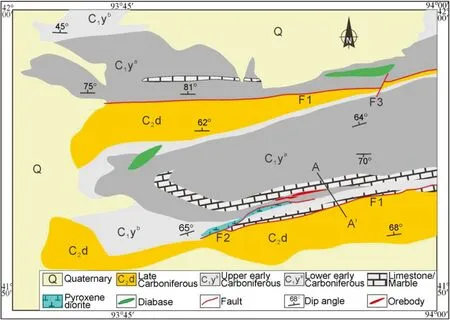
Fig. 2 General geology of the Yamansu iron deposit(modified after 1:50,000 geological maps)
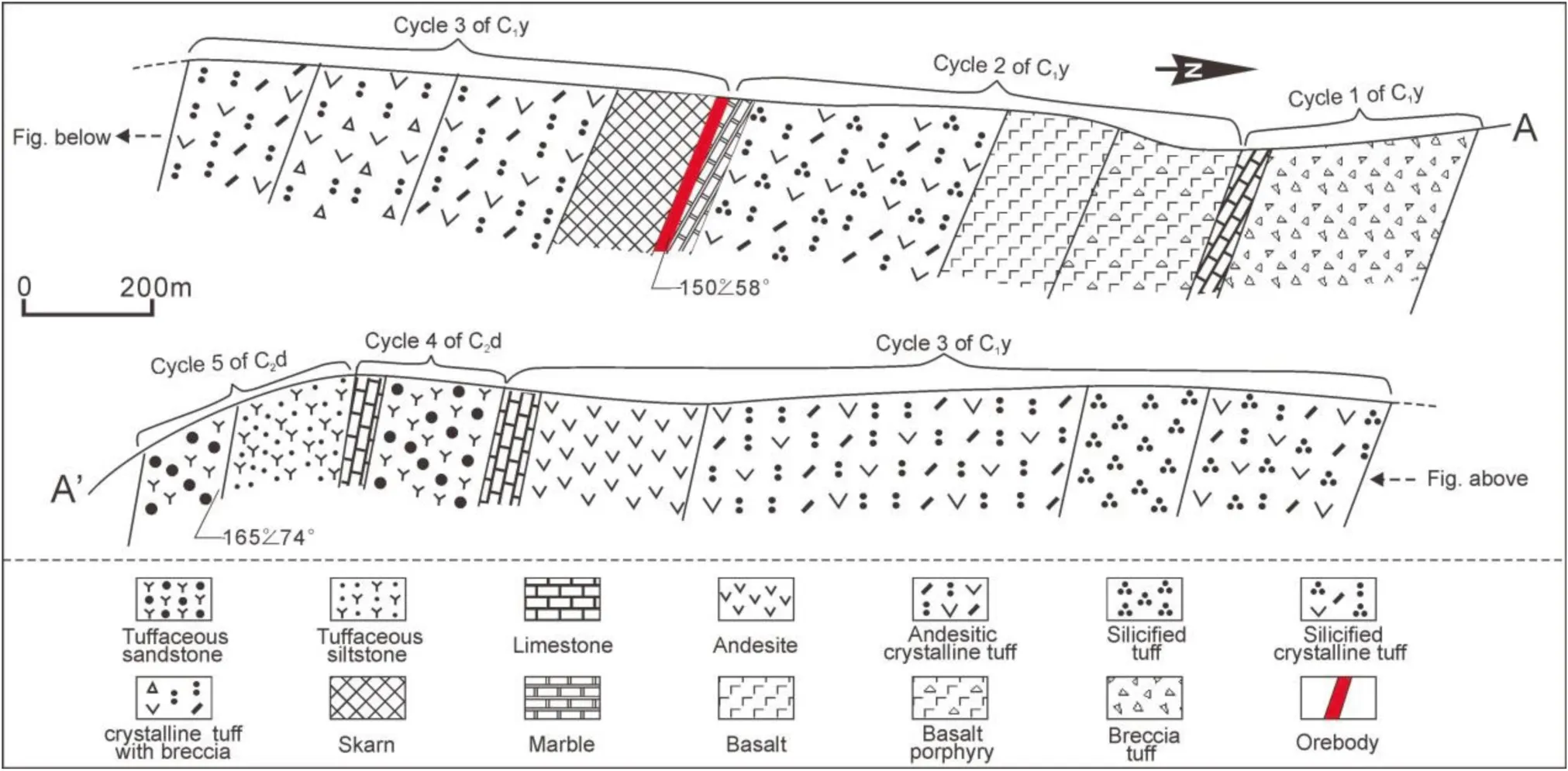
Fig. 3 Geological cross-section of the Carboniferous strata in the Yamansu ore district
3.2 Orebodies and ores
The Yamansu deposit contains 16 orebodies. These orebodies have a strike length of approximately 1640 m and a width of 100-200 m.The Yamansu orebodies are hosted in the Yamansu Formation(C1y),and they occur at the axis of the anticlinorium, which follows a nearly EW trend (the Sixth Geological Brigade of the Xinjiang Geological and Mineral Resources Bureau (SGBXGMRB 2005). These orebodies have developed into structures with stratified,stratoid or lens-like shapes and are broadly parallel to the host rocks.They dip to the south at angles of 35to 60°.Fe1 and Fe2+3 dominate the major orebodies in the Yamansu deposit.The Fe1 orebody occurs in the middle of the skarn and dips southward at an angle of 70°.The altered andesitic crystalline tuff and garnet are in the hanging wall while marble, tuff, skarn (chlorite, epidote, K-feldspar, and albite), and basalt are in the footwall (Fig. 4). The Fe2+3 orebody is located southeast of the Fe1 orebody with a clearance of 50 m. This orebody follows the contact between garnet skarn (hanging wall) and chlorite + epidote skarn (footwall). The Fe8 and Fe10 orebodies are hosted in the garnet skarn and chlorite + epidote skarn,respectively.
At the Yamansu deposit, four main ore types can generally be distinguished by their structures and sequences of formation: breccia ores, ores in the mineralized volcanic rocks, massive ores, and sulfide-rich ores. The brecciated ores are characterized by fragments of ores and altered volcanic rocks in garnet matrix. Figure 5a shows that the breccia magnetite and altered volcanic rock fragments are surrounded by garnet. This type of ore does not crosscut any mineral assemblages. The ores in the mineralized volcanic rocks consist of 35 %-40 % magnetite and some albite (35 %) and epidote (15 %) (Fig. 5b). This type of ore is generally replaced by veins of quartz ± sulfides or calcite.The massive ores are the main ore type and consist mainly of magnetite(high-grade with 85%-90 %total Fe)(Fig. 5c), together with minor amounts of pyrite, garnet,and chalcopyrite. The massive ores are essentially over printed or crosscut by mineral assemblages of sulfides(pyrite or pyrite ± quartz) (Fig. 5e). The sulfide-rich ores exhibit massive structures and are dominantly composed of magnetite (up to 80 % to 90 % total Fe) with minor sulfides. The sulfides in this type of ore display disseminated textures(Fig. 5d).In addition to the pyrite(Py1)coexisting with magnetite,later vein pyrite (Py2) is also developed in the Yamansu ore district. Py2 is generally associated with quartz and forms euhedral cubes and crosscuts massive magnetite (Fig. 5e) or disseminated magnetite in chlorite skarn (Fig. 5f).
Magnetite crystals in breccia ores are mostly euhedral to subhedral, range in size from 50 to 200 μm, and occur either as grains or enclosed by garnet (Fig. 6a). These magnetite grains may be synchronous with or slightly earlier than the garnet.The ores in the mineralized volcanic rocks have disseminated euhedral to anhedral magnetite crystals that are diverse, around 5 to 100 μmin size. These disseminated magnetite crystals are normally replaced by hematite along their rims(Fig. 6b).Microscopic features of magnetite crystals from the massive ores show various textures, such as irregular xenomorphic aggregate(Fig. 6c).Note that magnetite crystals in massive ores from Yamansuusually display zoned textures. The characteristics of internal zoned complexity differ significantly and can be subdivided into continuous and discontinuous zoned textures. Back scattered electron (BSE) imaging reveals that the continuous zoned magnetite crystals have concentric growth zones with alternating bright and dark magnetite regions (abbrev. Mt1 and Mt2, respectively;Fig. 6d, e). The discontinuous zoned magnetite crystals occur in the form ofrect angles, and quartz or chalcopyrite alteration can be seen along with their internal spaces or rims (Fig. 6f, g). The magnetite crystals coexisting with sulfide have anhedral shapes with dense groundmass. The pyrite crystals in these ores are fine to coarse(200-1000 μm) and have been fractured (Fig. 6h). Nevertheless,the later vein pyrite crystals associated with quartz and chalcopyrite have fine euhedral cubes and crosscut magnetite (Fig. 6i).
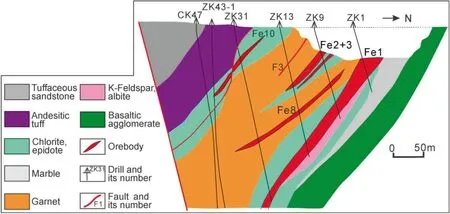
Fig. 4 Profile of the No. 43 exploration line in the Yamansu deposit (modified from SGBXGMRB 2005)
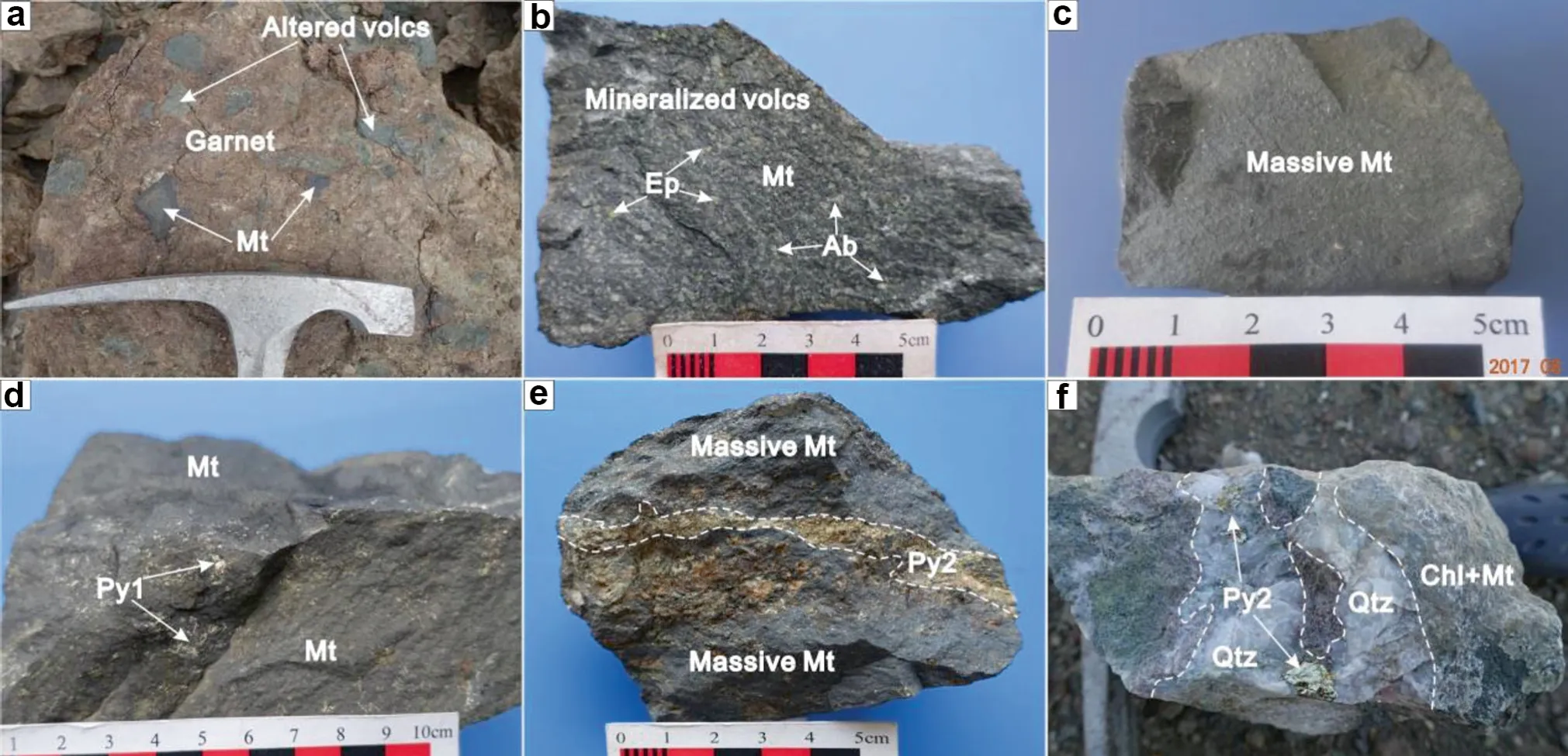
Fig.5 Field and hand specimen photographs of various ores from the Yamansu iron deposit.a Breccia ore consisting of breccia magnetite and altered volcanic rock fragments; b magnetite in the mineralized volcanic rocks intergrown with albite and epidote; c massive ore consisting of dense magnetite aggregates (up to >90 %); d magnetite associated with minor amounts of disseminated pyrite (Py1) in the sulfide-rich ores;e massive ore crosscut by vein pyrite(Py2);f chlorite + magnetite is crosscut by vein quartz + pyrite.Abbreviations: M—magnetite; Alted—altered; volcs—volcanic rocks; Ep—epidote; Ab—albite; Py—pyrite; Qz—quartz; Chl—chlorite
4 Sampling and analytical methods

Fig. 6 Backscattered electron images and reflected light images of representative magnetite and mineral assemblages from the Yamansu ore deposit.a Breccia ores have euhedral magnetite crystals varying in size with no evident zone and magnetite associated with garnet;b mineralized volcanic rocks have disseminated euhedral to anhedral magnetite crystals with diversely 5-100 μm grains that are intergrown with albite and replaced by hematite;c platy or dendritic aggregates in massive ores;d magnetite crystals in massive ores have continuous alternate zones with a darker central region; e magnetite crystals in massive ores have continuous alternate zones with a brighter central region and are replaced by quartz; f magnetite crystals have concentric growth zones with discontinuous textures; g discontinuously zoned magnetite replaced by chalcopyrite along internal spaces or rims; h magnetite crystals coexisting with sulfide (mainly fine- to coarse-grained pyrite) have anhedral shapes; i fine euhedral pyrite crystals (associated with quartz and chalcopyrite) crosscut magnetite. Imaging light sources: a, d, and e from backscattered electrons (BSE) and b, c, f, g, h, and i from on reflected light. Abbreviations: Mt—magnetite; Grt—garnet; Ep—epidote; Ab—albite; Hem—hematite; Mt1—magnetite with a brighter region; Mt2—magnetite with a darker region; Qz—Quartz; Ccp—chalcopyrite; Py1—pyrite coexisting with magnetite; Py2—vein pyrite coexisting with quartz and chalcopyrite
All samples for analysis were collected from the Yamansu open pit. Samples needed to be pretreated before the experiment.Polished thin sections were prepared forin-situtrace element analyses.The grain samples used for oxygen isotope and trace element analyses were processed. Magnetite grains separated from the massive ores and sulfiderich ores were used for oxygen isotope analysis. Pyrite grains separated from Py1 and Py2 were used for trace element analysis, and only optically clean pyrite grains without any visible impurities, selected under a binocular microscope, were used for analysis. In-situ LA-ICP-MS analyses were performed at the Key Laboratory of Marine Resources and Coastal Engineering, Sun Yat-sen University, using an ArF excimer laser ablation system coupled with an Agilent 7700x ICP-MS. Detailed analytical methods followed those in Gao et al. (2013) and Huang et al.(2013). Standard reference materials NIST-610, GSE-1G,and BHVO-2G were used as the external standards, and57Fe was used as the internal standard(Gao et al.2013;Liu et al. 2008). Offline data selection and integration of background and analyzed signals,time-drift correction,and quantitative calibration for trace element analysis were performed using ICPMS Data Cal software (Liu et al.2008).The δ18O values of magnetite grains were measured at the Beijing Research Institute of Uranium Geology,China. The oxygen isotopes of magnetite grains were obtained by the conventional method in which the minerals reacted with BrF5at high temperatures (Clayton and Mayeda 1963). Then, the liberated oxygen reacted with a hot platinized graphite rod at high temperature to produce carbon dioxide for mass spectrometry analysis, which was determined using a Finnigan MAT-252 mass spectrometer.The oxygen isotope data were reported in per milliliter relative to Vienna standard mean ocean water (SMOW)with analytical precisions of ± 0.2 ‰ for δ18O values.The trace element concentrations of pyrites were analyzed at the Beijing Research Institute of Uranium Geology, China by high resolution inductively coupled plasma mass spectrometry (NexION300D) under conditions with a temperature of 20 °C and a humidity of 30 %. The trace element concentrations were obtained by external calibration and internal standardization to correct for instrumental drift and matrix effects.
5 Results
5.1 Trace element composition of magnetite
A total of 71 analyses were performed on magnetite samples from Yamansu, and the detailed analytical results are listed in E-Table 1. As shown in Fig. 7, magnetite crystals in breccia ores have the highest concentrations of V,Ti,Ni,and Co, whereas they have the lowest concentrations of Mg, Si, Mn, Ca, Ga, and Al. Magnetite crystals from ores in the mineralized volcanic rocks have high Cr,V,Ni,Co,Ti, and Mn contents. Magnetite crystals in massive ores show some variation in chemistry and have compositions different from the two types of ores above. They have relatively high concentrations of Ca, Si, and Ga, and low concentrations of Ti,V,Cr Co,and Ni.Compared to all the types of ores above, the magnetite crystals coexisting with sulfide have the lowest Cr, Ni, V, and Ti contents. Generally, the dataset of magnetite trace element contents shows decreasing trends of Ti, V, Ni, and Co and increasing trends of Si concentrations from the breccia through the mineralized volcanic rocks to the massive ores and sulfide-rich ores. In addition, the chemical investigation of continuous zoned magnetite shows that Mt1 has higher Li + Be,Na,Al,Si,Ca,Sr,Ti,Ga,Ni,Ti + V,and Al + Mn contents than Mt2 (Fig. 8).
5.2 Magnetite O isotopes
E-Table 2 lists the oxygen isotope data for Yamansu magnetite grains, which use the standard δ18O no tation relative to SMOW after Hoefs (1997). The ten oxygen isotope analyses range between + 1.3 to + 7.0 ‰, with the distribution relatively dispersed.Eight magnetite grains from massive ores have δ18O values ranging from 1.3 to 6.4 ‰ (average 3.7 ‰), which are dominantly distributed in the range associated with the ortho-magmatic magnetites (1.0-4.0‰, highlighted with a translucent pink box in Fig. 12, after Taylor 1967). The magnetite grains coexisting with sulfide have high δ18O values ranging from 6.8 to 7.0 ‰ (average 6.9 ‰).
5.3 Trace element composition of pyrite grains
Nine pyrite samples were analyzed,and detailed resultsare listed in E-Table 3.Pyrite grains coexisting with magnetite have relatively low concentrations of total rare earth elements (ΣREE) (0.23 to 1.62 ppm) and LREE/HREE ratios(6.00 to 25.49 ppm) and have LaN/YbNratios of 5.02 to 54.16, δEu = 0.56-1.23, and δCe = 0.84 to 0.93. The concentrations of Cu (265 to 6055 ppm), Zn(15-221 ppm), and Pb (14-316 ppm) are also relatively low in the pyrite grains coexisting with magnetite. They have Co contents ranging from 486 to 6186 ppm and Ni contents ranging from 42 to 629 ppm and have high Co/Ni ratios ranging from 3 to 29(average 14).Pyrite grains from the later stage veinpyrite ± quartz (Py2) have very low concentrations of ΣREE (0.37-0.70 ppm) and LREE/HREE ratios (6.28-7.41 ppm) and have LaN/YbNratios of 4.53-16.98, δEu = 0.60-0.87, and δCe = 0.76-1.04. The concentrations of Cu (1909-6565 ppm), Zn(381-15,378 ppm), and Pb (22-5610 ppm) are relatively high in the pyrite grains from the vein pyrite ± quartz.They have Co contents ranging from 621 to 878 ppm and Ni contents ranging from 203 to 664 ppm and have low Co/Ni ratios ranging from 1 to 3.
6 Discussion
6.1 Magmatic-hydrothermal evolution of iron mineralization
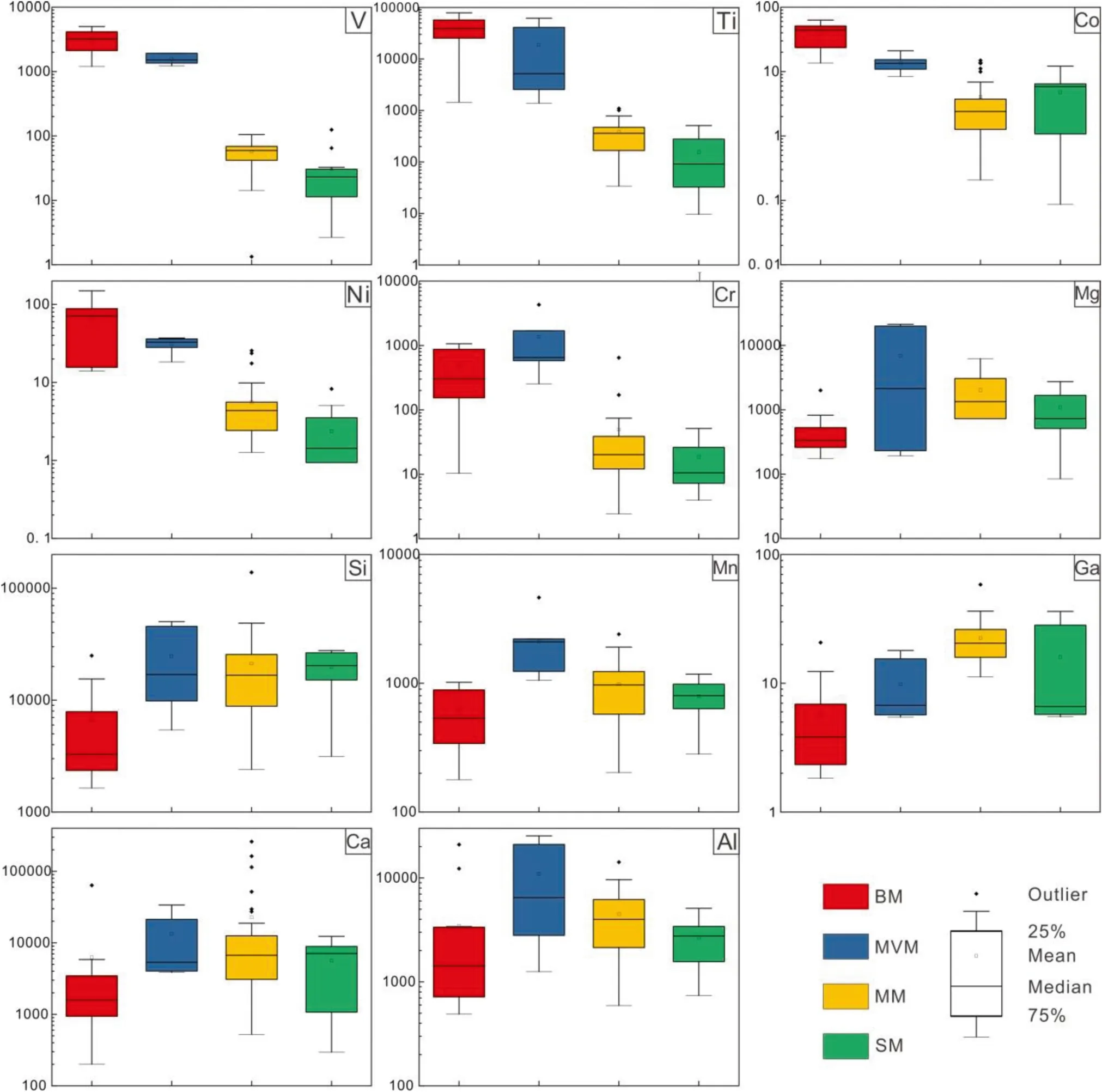
Fig. 7 Box and whisker plots for magnetite from different types of ores at the Yamansu deposit
As mentioned above, the Yamansu orebodies were deposited in the andesitic crystal tuff during the third cycle of the Carboniferous Yamansu Formation and shared occurrence state of the host rocks, revealing an affinity between mineralization and volcanism. Field evidence of breccia ores and their intimate intergrowth with altered volcanic rock fragments supports a signature of magmatic hydraulic fracturing (Naslund et al. 2002; Naranjo et al. 2010;Güntheret al. 2017). Moreover, the magnetite crystals in the breccia ores have high contents of Ti,V,Ni,and Cr and low contents of Si,Mg,and Ca,indicating that this type of ore formed in a magmatic or high-temperature environment(Ray and Webster 2007; Dupuis and Beaudoin 2011). The low Cr/Ni ratios and high Ti contents from breccia magnetite are also in accordance with an origin asigneous magnetite (Dare et al. 2014). Magnetite crystals from ores in the mineralized volcanic rocks have moderate contents of Ti, V, Ni, and Co and show transitional chemical characteristics between those of magmatic and hydrothermal magnetite.This situation may suggest that the primary magnetite crystals had a composition similar to that of magnetite from volcanic rocks and then were altered by hydrothermal fluid(Broughm et al.2017).This explanation has been proven by the photomicro graph of magnetite replaced by hematite (Fig. 6b). In contrast, the magnetite from massive ores and sulfide-rich ores have clearly low Cr, Ni, V, and Ti and high Si, Ca, and Mg contents, most likely implying that these magnetites formed in hydrothermal environments(Dare et al.2012,2014;Nadoll et al.2014;Zhou et al.2017).Furthermore,these two types of ores are closely associated with hydrothermal minerals such as chlorite, epidote, actinolite, quartz, and pyrite,which is similar to hydrothermalmagnetite ores.
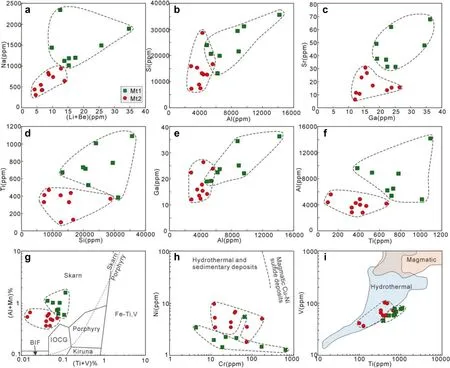
Fig. 8 Binary diagrams of the trace elements in Mt1 (brighter region) and Mt2 (darker region) from massive ores of the Yamansu ore deposit.Figure 7g is modified from Nadoll et al.(2014);Fig. 7h is modified from Dare et al.(2012);and Fig. 7i is modified from Knipping et al.(2015)
In the discriminant diagram of Ni/Cr versus Ti(Fig. 9a),although magnetite samples from breccia ores (abbrev.BM) and mineralized volcanic rocks (abbrev. MVM) plot within the magmatic magnetite field, some of the massive magnetite (abbrev. MM) and magnetite coexisting with sulfide (abbrev. SM) also plot within this field. This result indicates that the ore-forming temperatures of magnetite in the Yamansu iron deposit were relatively high. However,all the magnetite samples from breccia ores and mineralized volcanic rocks plot within the magmatic magnetite field, and most of the massive magnetite and magnetite coexisting with sulfide plot within the hydrothermal magnetite field (Fig. 9b). Additionally, in the discriminant diagrams of Ti + V versus Ca + Al + Mn and Ti + V versus Ni/(Cr + Mn), most magnetite samples from breccia ores along with minor magnetite samples from the mineralized volcanic rocksplot within the Fe-Ti,V deposit field, and all the massive magnetite and magnetite coexisting with sulfide plot within the skarn deposit field(Fig. 10). Moreover, multiple binary diagrams of the trace elements for various types of ores further imply the magmatic-hydrothermal process (Fig. 11).
The δ18O values of the magnetite grains in the Yamansu deposit are all positive(+ 1.3 to + 7.0‰),suggesting that they precipitated from high-temperature fluids (Jonsson et al. 2013; Güntheret al. 2017). On the chart of oxygen isotope values, the Yamansu magnetite samples cover the ranges of volcanic iron deposits(including the Kiruna-type and volcanic-type iron deposits in the western Tianshan)compared to the other types of deposits(Fig. 12).The δ18O values increase from the massive magnetite to magnetite coexisting with sulfide, showing an ortho-magmatic-hydrothermal process (Jonsson et al. 2013).
In summary, based on the petrographic features, trace element compositions,and oxygen isotope values from the Yamansu deposit, our preferred interpretation disagrees with an exclusively hydrothermal origin and rather supports a magmatic-hydrothermal process during iron formation.
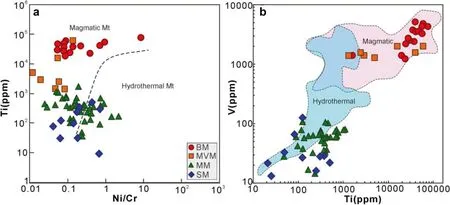
Fig.9 Magnetite samples from different types of ores at the Yamansu deposit plotted on the Ti versus Ni/Cr(a,proposed by Dare et al.2014)and Ti versus V (b, proposed by Knipping et al. 2015) discrimination diagrams
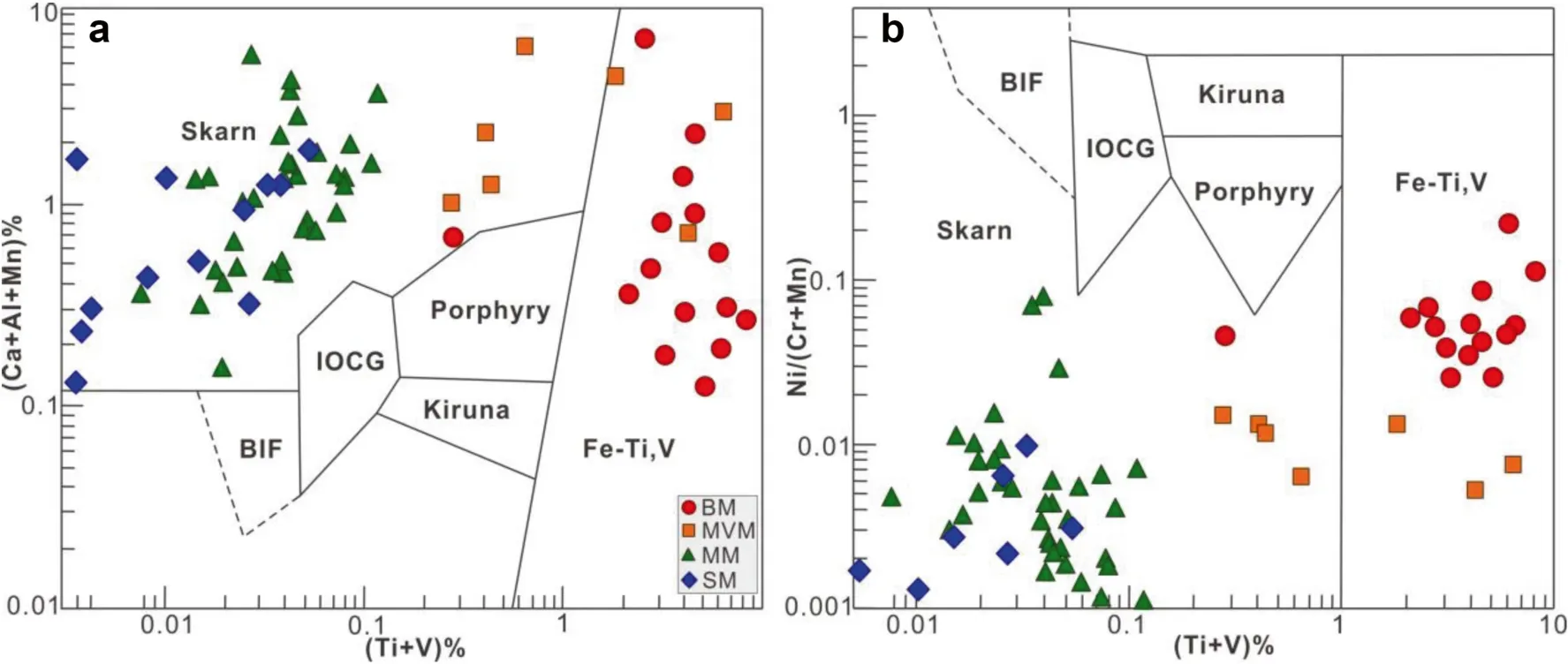
Fig. 10 a Discrimination diagrams of Ti + V versus Ca + Al + Mn and b Ti + V versus Ni/(Cr + Mn) for different types of ores from the Yamansu deposit. Reference fields are adapted from Dupuis and Beaudoin (2011)
6.2 Ore-forming conditions
6.2.1 Temperature
The incorporations of Ti, Ni, Cr, and V in magnetite are temperature-dependent (Nielsen et al. 1994; Toplis and Corgne 2002). Many studies have demonstrated that these elements preferentially enter the magnetite lattices and can isomorphically substitute for iron ions at high temperature due to their similar ion radii and valence states(Dare et al.2012; Liu et al. 2015; Zhou et al. 2005, 2013). On the contrary, Si, Mg, and Ca are usually more mobile than Ti,V, and Ni under hydrothermal conditions (Nielsen et al.1994; Dare et al. 2014), which has been demonstrated by obvious variations of Si, Mg, and Ca during the dissolution-reprecipitation process in skarn, IOCG, and IOA deposits (Hu et al. 2014; Huang et al. 2018, 2019).Magnetite in breccia ores from the Yamansu deposit is enriched in Ti, Ni, Cr, and V and is considered to be of magmatic or high-temperature fluid origin. The moderate contents of V, Ni, Co, and Ti probably reflect minor hydrothermal alterations or fluid-rock interactions during the formation of magnetite from the mineralized volcanic rocks (Liu et al. 2018). However, the data on magnetite from massive ores and magnetite coexisting with sulfide clearly show decreasing contents of Ti, Ni, Co, Cr, and V,suggesting a temperature decrease(Ilton and Eugster 1989)(Fig. 13a, c). Nadoll et al. (2014) proposed that both Ti + V and Al + Mn contents in magnetite have positive correlations with formation temperatures. Although the magnetite from massive ores and sulfide-rich ores have even higher (Al + Mn)% contents (Fig. 11f), the temperature may not be amajor or the sole controlling factor during the formation of magnetite (controlled by, e.g.,fluid-rockinteraction, as discussed below).
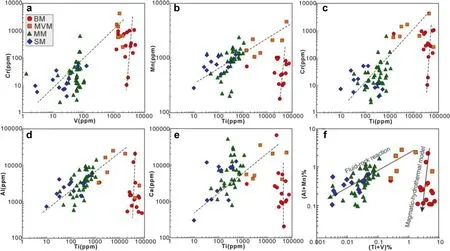
Fig. 11 Binary diagrams of the trace elements in magnetite from different types of ores in the Yamansu deposit. The magmatic-hydrothermal model and fluid-rock interactionsare proposed by Liu et al. 2018
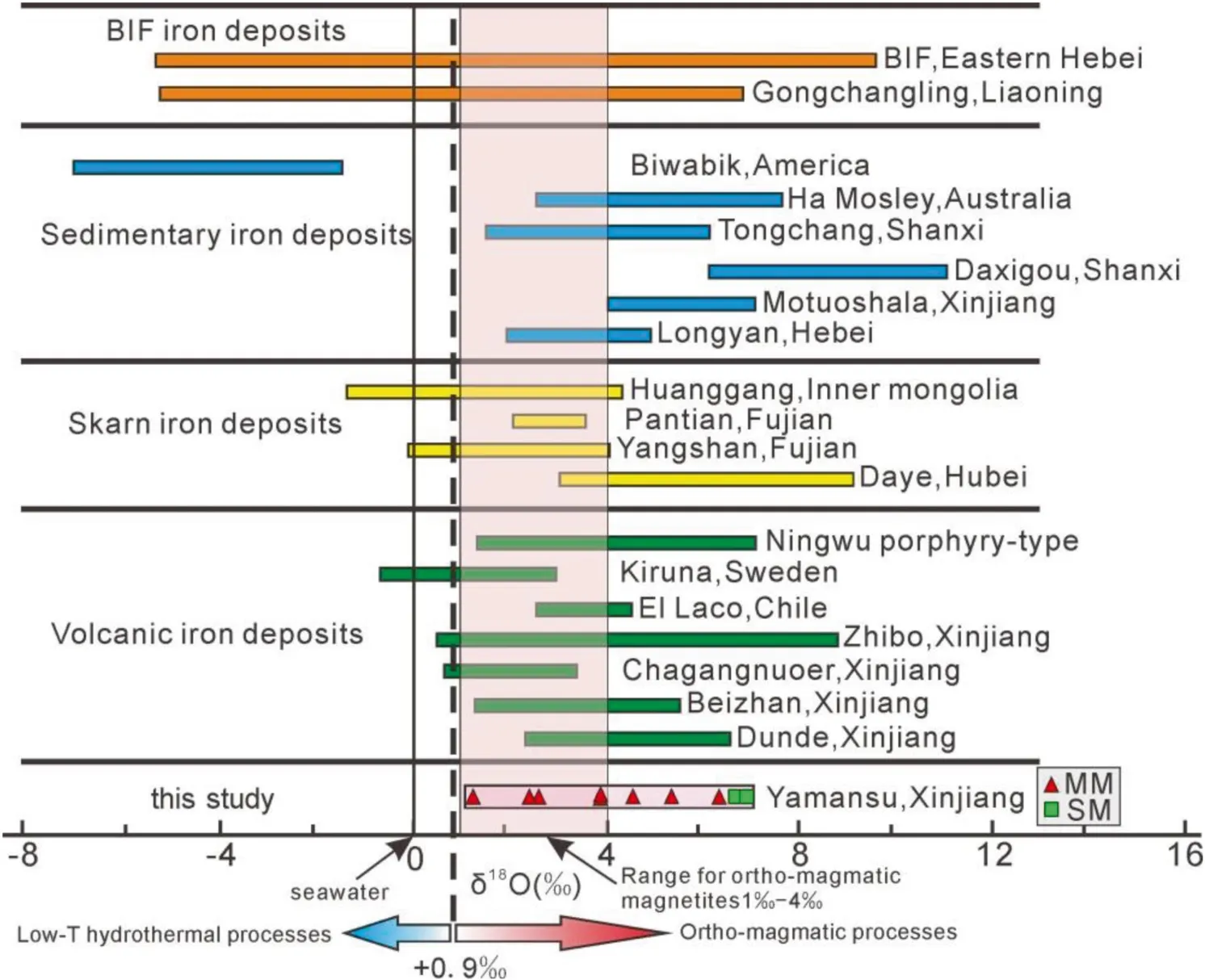
Fig. 12 Magnetite δ18O values from the Yamansu iron deposit compared with those from other iron deposits(modified from Jonsson et al.2013).The range for ortho-magmatic magnetites is from Taylor(1967).The Dunde and Beizhan data are from Li(2012).The Chagangnuoer data are from Hong(2012)andZhang(2013).TheZhibodataarefromWang(2013)andJiang(2014).TheKirunaandElLacodataarefromJonssonetal.(2013)andNyström et al.(2008).The Ningwu data are from Yuan et al.(1997).Other data are from Hong(2012)and Zhao et al.(2012)
Studies have shown that trace elements in pyrite can also probably reflect the formation temperatures (Brill 1989; Song and Zhang 1986; Monteiro et al. 2008). The concentrations of Co and Ni and the Co/Ni ratios may be ascribed to different hydrothermal deposits or used in restoring relative temperatures (Xu 1998; Monteiro et al.2008).In the Yamansu deposit,the pyrite grains coexisting with magnetite have relatively higher Co and lower Ni contents and higher Co/Ni ratiosthan the vein pyrite grains(Fig. 14a), suggesting that the formation temperatures of pyrite grains coexisting with magnetite were higher. Furthermore, the enrichment in Zn/(Zn + Pb) and depletionin (Cu + Zn + Pb)/(Co + Ni) for the pyrite grains coexisting with magnetite are further attributed to a hightemperature fluid (Fig. 14b) (Chen et al. 1997).
6.2.2 Fluid and host rock buffering
In addition to temperature, other physiochemical conditions (fluid compositions and host rock buffering) also controlthe solubility of trace elements in magnetite(Toplis and Corgne 2002; Dare et al. 2014; Nadoll et al. 2014 and references therein; Knipping et al. 2015). The contents of Ti, Cr, V, Co, and Ni in magnetite from breccia ore are very high and indicate that fluid-rock interactions played a very limited role in the abundance of these elements(Chen et al. 2015) (Fig. 11). Nadoll et al. (2014) and Xie et al.(2017) noted that elements such as Mg, Al, Zn, and Si are preferentially correlated to fluid-rock interactions affecting the compositions of magnetite and can be indicators of the formation of hydrothermal magnetite. In this case, Al/Co and Zn/V are good indicators for fluid-rock interactions.As mentioned above, fluid-rock interactions played an important role in the formation of magnetite from massive ores and sulfide-rich ores. As shown in Figs. 13d and 13e,elevated contents of Mg, Si, Al/Co, and Zn/V of the magnetite from massive ores and sulfide-rich ores indicate hydrothermal fluid effects and strong fluid-rock interaction during the formation of magnetite (Chen et al. 2018). We have shown that magnetite crystals from the massive ores have zoned textures and that elements are zoned in the magnetite and seem to have fluctuated during magnetite growth.Such zonesare indisputably hydrothermal in origin and record fluctuating fluid composition,suggesting that the magnetite crystallized through dissolution-precipitation with fluctuating temperature,fluid-rock interactions,or/and host rock buffering conditions (Dare et al. 2014, 2015; Hu et al,2014).
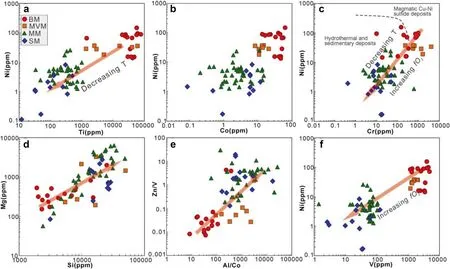
Fig. 13 Binary diagrams of a Ti versus Ni, b Co versus Ni, c Cr versus Ni, d Si versus Mg, e Al/Co versus Zn/V and f V versus Ni for the magnetite samples from different types of ores in the Yamansu deposit.Fields for Cu-Ni sulfide deposits,hydrothermal and sedimentary deposits(12c) are from Dare et al. (2012)
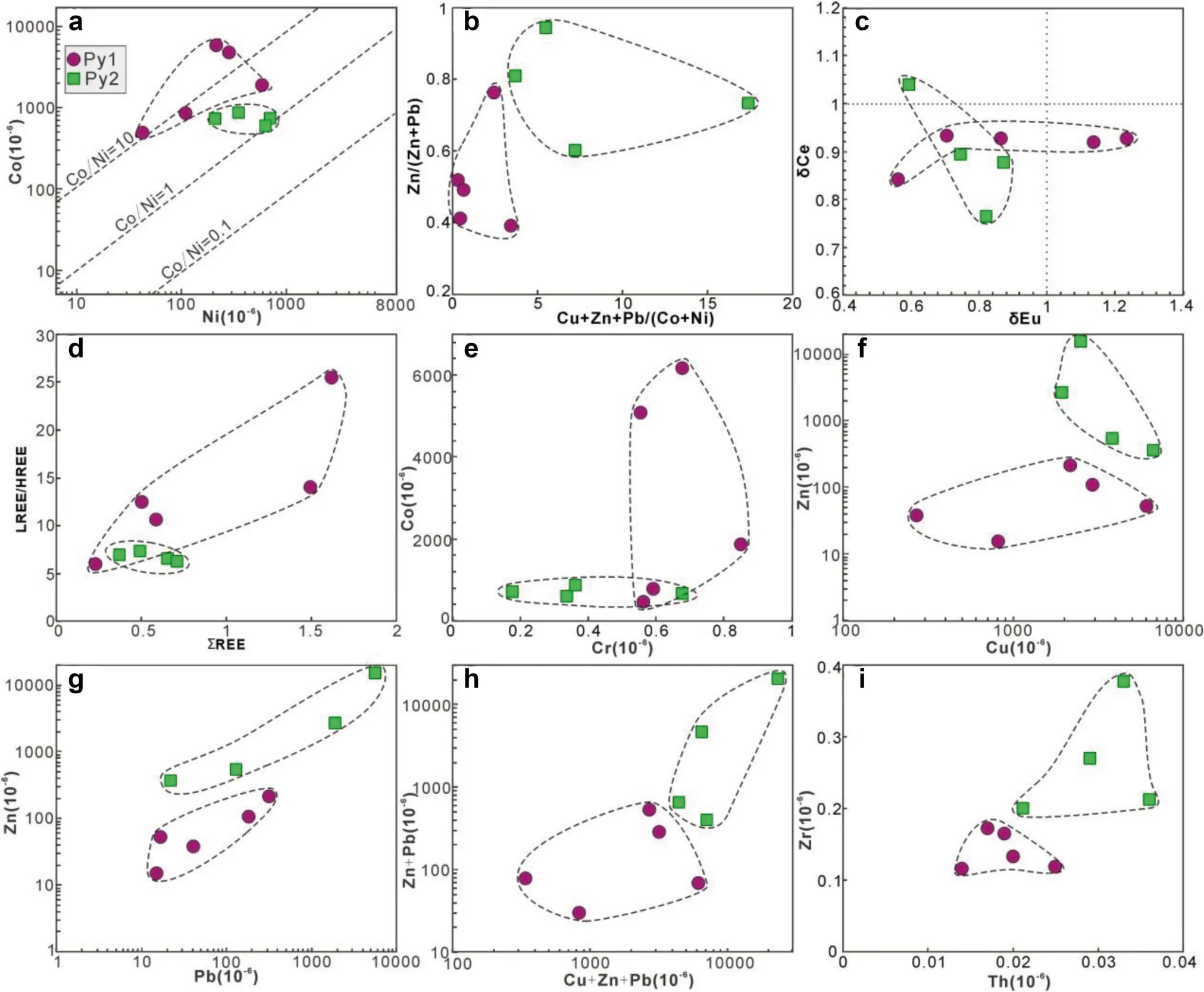
Fig. 14 Binary diagrams of the trace elements from different pyrite samples in the Yamansu deposit
6.2.3 Oxygen and sulfur fugacities
Elements, such as V, Cr, and Ni have diverse chemical valence states, and their behavior is strongly related to oxygen fugacity (Righter et al. 2006; Nadoll et al. 2014;Corriveau et al. 2016). The distribution coefficients of V,Cr, and Ni decrease when the oxygen fugacity increases;hence,V, Cr, and Ni are readily partitioned into magnetite under lower oxidizing condition (Goldschmidt 1958;Carew 2004; Huang et al. 2018). The concentrations of V and Cr tend to decrease from the breccia magnetite and the magnetite in mineralized volcanic rocks through the massive magnetite to the magnetite coexisting with sulfide(Fig. 13c, f), which indicates increasing oxygen fugacity during the evolution of ore-forming fluids (Klemme et al.2006; Meric et al. 2012). However, zoned magnetite crystals in the massive ores show limited changes in V and Cr (Fig.8h, i), indicating that oxygen fugacity is not an important factor controlling trace elements into magnetite during Mt1 and Mt2 formation. In addition, oxygen fugacity may control the concentrations of Eu and Ce in pyrite, and in this way, increasing oxygen fugacity decreases the solubility of Euand increases the solubility of Ce (Graf 1977; Mills and Elderfield 1995; Clark et al.2004; Craddock et al. 2010). From the pyrite coexisting with magnetite to the vein pyrite, the changes from clear positive or negative Eu anomaly to negative Eu anomaly and from negative Ce anomaly to positive or negative Ce anomaly (Fig. 14c) indicate an increasein oxygen fugacity during hydrothermal fluid evolution.
Under sulfide-dominated conditions,sulfur fugacity may be the primary control for the partitioning of relevant elements (Dare et al. 2012; Nadoll et al. 2014). Because sulfides occur extensively in the Yamansu deposit and given the existence of magnetite coexisting with sulfide and vein pyrite, the formation of these mineral assemblages is expected to have occurred at high sulfur fugacity. In addition, sulfur fugacity can affect the distribution coefficients of trace elements in sulfides. The sulphophile elements would strongly partition into sulfides,whereas lithophile or siderophile elements may be relatively depleted in the sulfides under high sulfur fugacity(Ewart and Griffin 1994; Morse and Luther 1999; Simon et al. 2008; Heiligmann et al. 2008; Nadoll et al. 2014). In the Yamansu deposit, the pyrite grains coexisting with magnetite have relatively lower concentrations of sulphophile elements such as Cu, Mo, Pb, and Zn (or Cu +Zn + Pb) and higher concentrations of lithophile or siderophile elements such as ΣREE,LREE/HREE,Zr,Th,Co,and Cr (Fig. 14d-i), which suggests that the vein pyrite grains precipitated at higher sulfur fugacity than the pyrite grains coexisting with magnetite.
7 Conclusions
(1) A geological cross-section of Carboniferous strata in the Yamansu ore district shows that orebodies were deposited in andesitic crystal tuff during the third cycle of the Yamansu Formation(C1y)and generally shared the occurrence state of the host rocks,revealing an association between mineralization and volcanism.
(2) Petrographic features, in-situ trace element compositions, and oxygen isotope values of magnetite samples, do not suggest that the Yamansu deposit had an exclusively hydrothermal origin but rather support the role of magmatic-hydrothermal processes during iron formation.
(3) The formation process for the Yamansu iron deposit changed from high temperature and low oxygen fugacity to low temperature and high oxygen fugacity. More fluid-rock interactions and higher sulfur fugacity were involved during the deposition of massive ores and sulfide-rich ores in the late stage than in the early stage.
AcknowledgementsThis research was supported by the National Key R&D Program of China (2018YFC0604006 and 2017YFC0601204) and the National Basic Research Program of China (973 Program, 2014CB440803).
杂志排行
Acta Geochimica的其它文章
- Late Ordovician mass extinction caused by global warming or cooling?
- Geochemical constraints on the origin of Early Cretaceous alkaline intrusions and its tectonic implication, Sulu Orogenic Belt, Eastern North China Craton
- Hydrogeochemical characteristics of groundwater and quality assessment for the purposes of drinking and irrigation in Bougaa area, Northeastern Algeria
- Organic geochemical characteristics of Eocene crude oils from Zhanhua Depression, Bohai Bay Basin, China
- Geochronology and geochemistry of magmatic rocks in the Dongzi-Changhanboluo Pb-Zn ore district in Chifeng,Inner Mongolia, and their relationship with metallogenesis
- Zircon U-Pb dating, geochemical, and Sr-Nd-Pb-Hf isotopicconstraints on the age and origin of intermediate to felsic igneous rocks at South Altyn, Xinjiang, China
